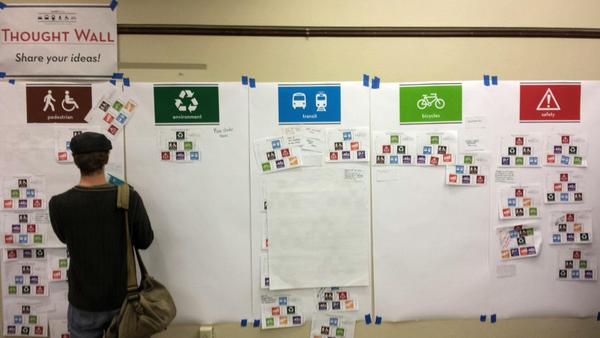Transit priority lanes considered for the Drag
Friday, February 13, 2015 by
Jenny Blair Close to half of all rush-hour travelers through the Drag may go by bus, and the busy corridor’s future may include dedicated bus lanes, commissioners learned at Tuesday’s Urban Transportation Commission meeting.
The Austin Transportation Department is studying ways to improve the design of the notoriously congested stretch of Guadalupe Street between MLK Jr. Boulevard and 29th Street, including sidewalks, as part of the city’s Corridor Development Program. The department is also studying South Lamar through the program.
Grass-roots organization AURA, meanwhile, is doing studies of its own. During a recent Monday evening rush, its volunteers counted an hour’s worth of travelers through the Drag and found that some 45 percent were bus passengers. AURA turned the data over to the department for use in analyses, as well as to Capital Metro.
AURA member Roger Cauvin told commissioners it was encouraging to see bus ridership that high, despite “somewhat poor travel times.”
Alan Hughes, a project manager with the ATD, told the commission that its corridor studies aim to improve multi-modal transportation and support mixed-use development, in accordance with the Complete Streets ordinance.
To develop recommendations for Guadalupe, the city is working with design consultant Kimley-Horn and Associates, Inc. and the Center for Transportation Research, which is modeling three traffic scenarios for the Drag using Capital Metro and AURA’s ridership data. The Capital Area Metropolitan Planning Organization is paying CTR to do the work as a demonstration project, according to Hughes.
The Guadalupe corridor consists of four lanes flanked in part by two unprotected bike lanes as well as sidewalks largely in need of improvements. It contains about 70 street parking sites. Businesses line much of one side and the University of Texas much of the other, leading to serious right-of-way barriers to widening the road. Long debated by transportation reformers, it is heavily trafficked by motor vehicles, bicycles and pedestrians and is considered one of the busiest stretches of road in Austin.
In addition to dedicated bus lanes, also known as transit priority lanes, the CTR is analyzing the potential effects of moving the Drag’s bus routes west to San Antonio or Nueces streets and diverting more cars to that area.
The latter two scenarios, Hughes said, raise the question of how traffic will rejoin Guadalupe north of the university.
Since January 2014, transit priority lanes for MetroRapid buses have existed on downtown Guadalupe and Lavaca streets between Cesar Chavez Street and MLK Jr. Boulevard.
AURA conducted another study on Thursday evening’s rush hour to compare the speeds of buses on those downtown transit priority lanes with those traveling the Drag.
Urban Transportation Commissioner Jace Deloney asked Cauvin whether AURA has any policy recommendations yet. Cauvin replied that they didn’t.
“What we wanted to do was look at it through the lens of how many people you’d be able to move through (the Drag) and be able to do projections on that and say, ‘Hey, look, the numbers don’t lie,'” Cauvin said.
In response to a question from Deloney, Hughes said the study is not considering dynamic lanes, in which smart traffic signals switch motor vehicles’ direction of travel according to rush-hour demand.
Deloney told the Monitor that he was pleasantly surprised that ATD is taking transit priority lanes seriously, saying that many commenters at a Dec. 3 open house were vocal about wanting dedicated lanes on the Guadalupe corridor. Deloney added that he was concerned that ATD was not looking into dynamic lanes.
Hughes told the Monitor that the dynamic-lane scenario did not come up in discussions.
“Only having one lane in one direction can be problematic if somebody wants to turn or is trying to park, or there’s a vehicle breakdown,” Hughes said.
Results of the Guadalupe study and a preliminary report with recommendations will come out in April or May for another public open house, according to Hughes. He said a final report will be released over the summer.
No bond money exists for traffic improvements on the Drag, though the 2012 bond election did allocate some funds to the South Lamar corridor. According to ATD assistant director Gordon Derr, the next step for Guadalupe is to secure money for designs that could then be put to a bond ballot initiative in 2016.
This story has been corrected to reflect the fact that the transit priority lanes are employed by all buses, not just MertoRapid buses.
Public comments on the Drag at last December’s open house. Many commenters called for dedicated bus lanes. Photo courtesy Jace Deloney.
You're a community leader
And we’re honored you look to us for serious, in-depth news. You know a strong community needs local and dedicated watchdog reporting. We’re here for you and that won’t change. Now will you take the powerful next step and support our nonprofit news organization?








